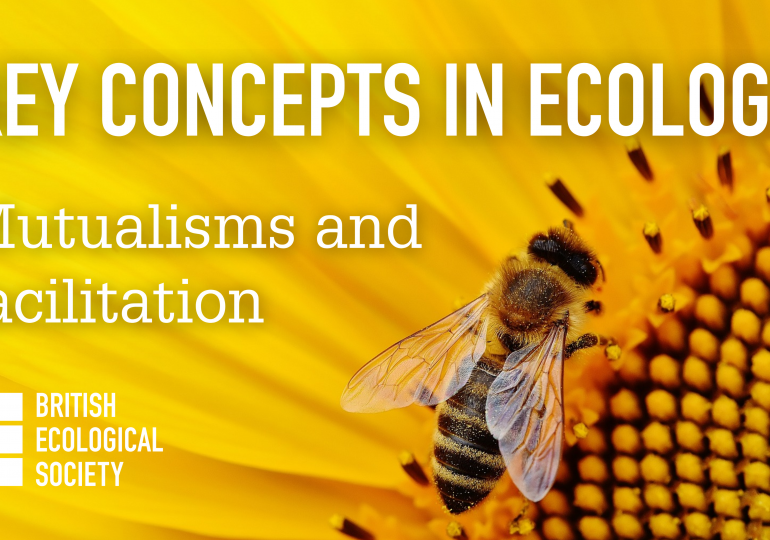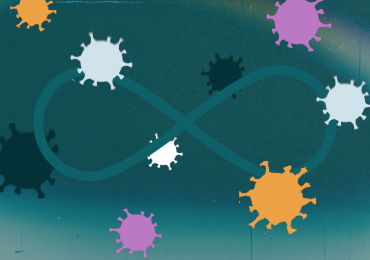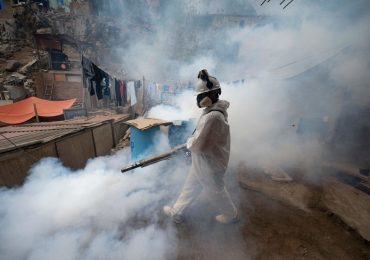This blog post on ‘Mutualisms and facilitation’ is part of the BES ‘Key Concepts in Ecology’ series, designed to help ecologists in learning the key topics in ecology. See the full blog series for a list of key topics that you might typically find in an ecology textbook, each providing a short introduction to the topic, and a list of suggested papers for students to refer to.
Species in a community interact with one another, and the type of interaction can have implications for community dynamics and ecosystem function. We can define the type of interaction based on the net effects that species have on each other, with different combinations of positive, negative, or neutral effects (++, +-, –, +0, -0, 00). Mutualisms are defined as the outcome of interactions where all the species involved receive a net benefit (++). Facilitation often can be used interchangeably with mutualisms; however, there are cases of facilitation where the species being facilitated will have a net benefit while the facilitator has a neutral (+0) or even negative (+-) outcome (Bronstein 2009). Usually, facilitation occurs when a species alters the environment in a way that allows for other species to better grow, survive, or reproduce in that environment. Mutualism and facilitation are extremely important for ecosystem processes and functioning. For instance, facilitation is proposed to be implicated in the increase of biodiversity and productivity of plant communities (Wright et al. 2021). Additionally, mutualisms can be essential for ecosystem services as many plants rely on mutualisms with animals for their reproduction.
Pollination mutualism is extremely important for flowering plant reproduction, as it increases outcrossing and the chance of successful fertilization of plant gametes. To guarantee pollen delivery to their conspecific flowers, plants have evolved cues, such as visual and olfactory cues, to attract their pollinators. For instance, different color spectrums can attract different pollinators; plants can use UV to attract insects that can see in the UV spectrum (e.g., León-Osper and Narbona 2022). Similarly, the type of floral scent can vary within the same plant species, depending on the community of pollinators the plants need to attract (e.g., Manincor et al. 2021).
Plant reproduction can also greatly benefit from seed dispersal mutualisms with animals. Many plants produce seeds encapsulated with nutritious fleshy tissue used as food by animals (frugivores). Birds, mammals, and reptiles eat these fruits whole or by biting/pecking and breaking down the fruit. The animals that eat fruits can disperse the seeds by defecating viable seeds that will potentially germinate, many times away from other conspecifics, reducing competition between individuals of the same species. However, not all frugivores will be mutualistic; some frugivores can destroy the seeds, and in this case, the interaction would be antagonistic (+-) (e.g., Simmons et al. 2018).
Pollination and seed dispersal systems are increasingly being evaluated as a complex network of interactions, where many species are interconnected. Mutualistic networks tend to be nested, which means that these networks are composed of few generalist species that interact with both generalist and specialist partners (e.g., Chacoff et al. 2011). These few generalist species are often considered central species in the mutualistic networks, as they form interactions with most of the other species in the network. Central species can be important for network persistence and mutualism maintenance; for example, they can make pollination networks resistant to invasive species (e.g., Vitali et al. 2021) and provide greater seed dispersal benefits to plants (e.g., Acevedo-Quintero et al. 2020).
Mutualisms can be defined by the type of services or resources exchanged among partners. Besides dispersal mutualisms (pollination and seed dispersal mentioned above), other types include defensive and nutritional mutualisms. Considering defensive mutualisms, some plants offer some form of food, many times as extrafloral nectar (nectar not related to the reproduction of the plant), to animals that defend plants against herbivores. Ants are notorious bodyguards of plants, usually because ant workers rely on sugary liquids for energy and because ants tend to be territorial and remove other animals from the plants (e.g., Yamawo et al. 2021). Not only plants benefit from defensive mutualisms. For instance, aphids can host endosymbiotic bacteria that can produce toxins that defend the host against parasitoids (Oliver et al. 2013). Parasitoids themselves can house viruses that can suppress the caterpillar’s immunity such that the parasitoid offspring can evade the host’s immune response (Kaltenpoth and Engl 2013).
Lastly, nutritional mutualism can be important in providing scarce resources to mutualistic partners. For example, plants can form mutualisms with microorganisms associated with their roots, where the microorganisms provide limiting nutrients to the plant. Common associations with fungi in plant roots, known as mycorrhizae, provide nitrogen or phosphorous to the host plant (e.g., Casas et al. 2021). Legumes, for example, have nodules known as rhizobia in their roots that house nitrogen-fixing bacteria. The nitrogen fixed by these bacteria benefits not only the legume plant that bears them but also other plants around them, as the soil becomes enriched with nitrogen through decomposition of nitrogen-rich plant material (e.g., Bellingham et al. 2002). Mutualisms can allow species to occur where it would not otherwise. In fact, beneficial interactions have been suggested to potentially increase the realized niche of mutualistic partners. By providing nutrients to their partners, plants can grow in nutrient-poor soils. Similarly, fungus-growing ants that are cold-adapted can grow their fungus partner in colder regions even when the fungus itself is not cold-adapted (Senula et al. 2022).
Facilitation and mutualisms are context-dependent, and interactions that were once defined as mutualistic can become antagonistic or neutral depending on the context. For instance, defensive mutualisms are only beneficial for both species when there are detrimental natural enemies to be defended against. The benefit of mycorrhizae and rhizobia also depends on the provided nutrients being limiting. Besides influencing the outcome of the interaction, the environmental context can also determine the species or genotypes partners interact with, and the benefits associated with these interactions. For instance, habitat alteration can potentially negatively impact the seed dispersal service to plants due to changes in the communities of animals dispersing seeds, or due to changes in access to fruits (e.g., Zeng et al. 2018, Granados et al. 2019).
Introduction written by Mayra Vidal (Associate Editor, Functional Ecology). Reading list curated by the BES journal Editors.
References and suggested reading
Overview of mutualisms and facilitation
Bronstein, J.L. (2009), The evolution of facilitation and mutualism. Journal of Ecology, 97:1160-1170.
The ecosystem benefits of mutualisms and facilitation
Wright, A.J. et al. (2021), Biodiversity and ecosystem functioning: Have our experiments and indices been underestimating the role of facilitation? Journal of Ecology, 109:1962–1968.
Defense mutualisms
Special Feature (2014): Defensive symbiosis. Functional Ecology, 28:291-545
Yamawo, A. et al. (2021), Species diversity and biological trait function: Effectiveness of ant–plant mutualism decreases as ant species diversity increases. Functional Ecology, 35: 2012–2025.
Plant-pollinator mutualisms
Vitali, A. et al. (2022), A keystone mutualism promotes resistance to invasion. Journal of Animal Ecology, 91:74–85.
Chacoff, N.P. et al. (2012), Evaluating sampling completeness in a desert plant–pollinator network. Journal of Animal Ecology, 81:190-200.
León-Osper, M. et al. (2022). Unravelling the mystery of red flowers in the Mediterranean Basin: How to be conspicuous in a place dominated by hymenopteran pollinators. Functional Ecology, 36:2774–2790.
de Manincor, N. et al. (2022). Geographical variation of floral scents in generalist entomophilous species with variable pollinator communities. Functional Ecology, 36:763–778.
Plant-seed disperser mutualisms
Acevedo-Quintero, J.F. et al. (2020), From structure to function in mutualistic interaction networks: Topologically important frugivores have greater potential as seed dispersers. Journal of Animal Ecology, 89:2181–2191.
Simmons, B.I. et al. (2018), Moving from frugivory to seed dispersal: Incorporating the functional outcomes of interactions in plant–frugivore networks. Journal of Animal Ecology. 87:995–1007.
Granados, A. (2019), The influence of logging on vertebrate responses to mast fruiting. Journal of Animal Ecology, 88:892–902.
Zeng, D. (2019), Cascading effects of forested area and isolation on seed dispersal effectiveness of rodents on subtropical islands. Journal of Ecology, 107:1506–1517.
Nutritional mutualisms
Casas, C. et al. (2022), Loss of fungal symbionts at the arid limit of the distribution range in a native Patagonian grass—Resource eco-physiological relations. Functional Ecology, 36:583–594.
Senula, S.F. et al. (2022). Cold adaptations along a range limit in an obligate symbiosis. Functional Ecology, 36:2267–2278.
Leave a comment









